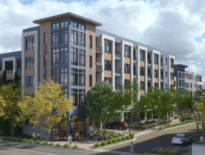A proposed 5.5-acre solar farm project in Lexington will be revised by developers after objections from Cambridge officials about the proximity to the Cambridge municipal water supply.
The Massachusetts Supreme Judicial Court ruled in June that state law protects solar projects from overly restrictive land-use regulations, and struck down the city of Waltham’s refusal to allow construction of an access road into the 30-acre site.
The wooded site has an address of 0 Cambridge St. and is located west of Route 128 between Route 2 and the Waltham line, next to the Hobbs Brook Reservoir which supplies Cambridge’s drinking water.
At a Lexington Planning Board hearing in December, Cambridge City Councilor Quinton Zondervan echoed the Cambridge Water Department’s comments that potential use of per- and polyfluoroalkyl substances [PFAS] in solar arrays would contaminate the Cambridge drinking water supply. The city switched to MWRA water supply from Aug. 30 until Nov. 19 to install carbon filters after detecting elevated PFAS levels in drinking water.
“I don’t even understand how in 2022 we’re having a calm conversion about this,” Zondervan said.
Harold Nahigian, trustee of Tracer Lane II Realty LLC, and Hopkington-based Solect Energy are seeking a major site plan approval from the planning board.
Cambridge officials have raised objections to the developers’ plans to cut down nearly 800 trees to make room for the over-1 million-megawatt solar farm. The solar array would occupy the western portion of the property, with an access road and connection to the electric grid at 119 Sherbourne Place in Waltham.
The Cambridge Water Department “strongly opposes” the project because of risks to Hobbs Brook Reservoir from the removal of vegetation and potential stormwater runoff onto Cambridge-owned watershed properties.
“Cambridge Water Department is concerned about erosion, vegetation damage, increased risk of invasive species establishment and encouragements on Cambridge watershed protection land as a result of this project,” Watershed Protection Supervisor Jamie O’Connell wrote in a Dec. 1 comment letter.
In a comment letter, the Waltham fire department said the site’s secluded location would delay and hamper response to a fire on the property. Waltham residents have formed an opposition group, Waltham Neighbors for Safe Solar, which has requested a buffer area for the project be increased from 50 to 200 feet.
The proposed ground-mounted solar farm is an allowed use in Lexington’s commercial manufacturing zoning district.
The plans will be updated to reflect public comments, Principal David LaPointe of engineers Beals + Thomas said at the initial hearing, which is scheduled to resume Feb. 15. Developers have requested a deadline for the board approval be extended until April 12.
The proposal was revived after a June ruling by the SJC which could benefit prospects for solar installations across Massachusetts.
After Waltham officials refused to issue a permit for the developer’s plans for the access road, citing an incompatible use in a residential neighborhood, developers filed suit in state Land Court in 2019.
In June, the SJC upheld the Land Court’s ruling in favor of developers.
In its decision, the SJC noted that solar projects and ancillary structures are protected by the Dover Amendment, a 1950 state law that also exempts schools and religious organizations from local zoning regulations.
Justices said Waltham zoning “unduly restricts solar energy systems” by only allowing them on 1 to 2 percent of the city’s land area.




 |
| 




